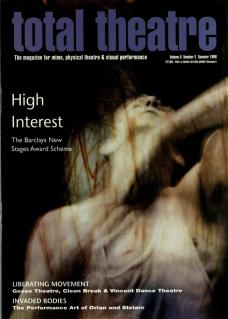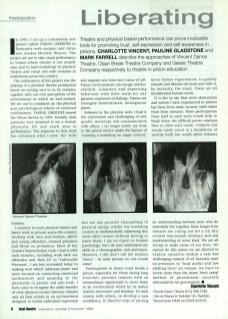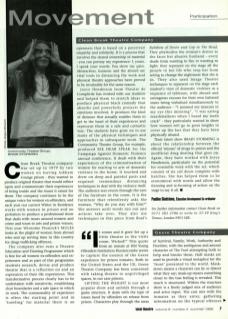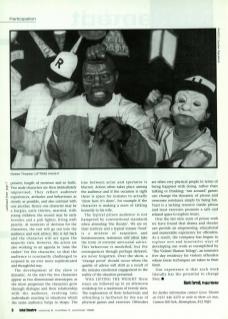Charlotte Vincent
In 1991, I set up a community arts project called Taking Liberties in Newcastle with sculptor and circus arts worker Michele Weaver. The project set out to take visual performance to venues where theatre is not usually seen and to lead workshops in physical theatre and visual arts with inmates in institutions across the country.
The culmination of this project was the making of a physical theatre production based on writing sent to us by inmates, together with our own perceptions of the environment in which we had worked. We set out to comment on the physical and psychological effects of enforced confinement. Taking Liberties toured the Prison Service in 1993. Initially male prisoners were surprised to see a woman physically lift and catch men in performance. The response to this work has informed what I now 'do' with inmates.
I continue to teach physical theatre and dance work in prisons across the country, working with men and women, adults and young offenders, remand prisoners and those on probation. Most of the Contact Improvisation work I lead is with male inmates, including work with sex offenders and 'Rule 43' or 'Vulnerable Prisoners'. I am less interested today in making work which 'addresses issues' and more focused on connecting emotional authenticity and meaning to the physicality of partner and solo work. I have come to recognise the subtle benefits of close physical contact between inmates and all that entails in an environment designed to forbid individual expression and separate one from one's sense of self. Prison environments encourage macho, childish, colourless and depressing behaviour with little room for any genuine expression of feelings. Prisons are strangely domesticated, incongruous places.
Inherent in the physical work I lead is the exploration and challenging of self, gender, stereotype and communication with others. I no longer justify my work to the prison service under the banner of running a workshop on anger control, but see the positive channelling of physical energy within the workshop context as fundamentally addressing this (and other issues) without having to name them. I am no expert in human psychology, but I do now understand my skills as a choreographer and performer. However, I still don't call my sessions 'dance' – in male prisons no one would come!
Participation in dance work inside a prison, especially for those facing long stretches, presents inmates with an extraordinary opportunity to move freely in an environment which by its nature restricts movement and freedom. To work closely with others, to develop a new confidence, to discover ways of moving never before experienced, to quietly educate and liberate the body and with it, by necessity, the mind. These are all fundamental human needs.
It is fair to say that most obstruction and sexism I have experienced in prisons has been from male security staff rather than from inmates. More participation from staff in such work would help to break down the difficult power relations that so often exist inside. I believe this would rarely result in a breakdown of security itself, but would rather enhance an understanding between men who do essentially live together. Most longer term inmates are crying out for a (in this context non-sexual) intimacy and real understanding of some kind. We are all trying to make sense of our lives. We cannot do this unless we are allowed to explore ourselves within a safe but challenging context. If we honestly want ex-prisoners to 'lead useful and law abiding lives' on release, we have to invest more than the inane 'boot camp' method of punishment currently advocated by our government.
Pauline Gladstone
Clean Break Theatre company was set up in 1979 by two women on leaving Askham Grange prison – they wanted to produce original theatre that would reflect upon and communicate their experiences of being inside and the issues it raised for them. The company continues to be the unique voice for women ex-offenders, and each year our current Writer in Residence works with women in prison and on probation to produce a professional show that deals with issues around women and crime and tours to arts and prison venues. This year Winsome Pinnock's Mules looks at the plight of women from abroad who end up serving time in this country for drugs trafficking offences.
The company also runs a Theatre Education and Training Programme which is free for all women ex-offenders and ex-prisoners and as part of this programme students research, devise and produce theatre that is a reflection on and an expression of their life experiences. This transformative process clearly has to be undertaken with sensitivity, establishing clear boundaries and a safe space in which to work. The commonality of experience is often the starting point and in 'trawling' for material there is an openness that is based on a perceived empathy and solidarity. It is a process that involves the shared ownership of material – you can portray my experience; I, yours. I speak your words; You show my pain. Abstraction, humour and the absurd are vital tools in distancing the work and physical theatre approaches have proved to be invaluable for the same reason.
Joyce Henderson from Theatre de Complicite has worked with our students and helped them to stretch ideas to produce physical black comedy that absorbs and powerfully projects the emotions involved. It produces the kind of distance that actually enables them to get to the heart of their experiences and represent them in a safe and cathartic way. The students have gone on to use many of the physical techniques and approaches in subsequent work. The Community Theatre Group, for example, produced See Hear Speak for the Campaign Against Domestic Violence annual conference. It dealt with their experiences of the criminalisation of women for reacting to acts of domestic violence in the home. It touched and drew on deep and painful pasts and required tremendous distancing techniques to deal with the violence itself. The audience sees events through the eyes of the furniture in the room. It is the furniture that relentlessly asks the woman, ‘Why do you stay with him?’ She answers until words run out and actions take over. They also use King's techniques in this piece from Boal's Rainbow of Desire and Cop in The Head. They physicalise the woman's desires as she faces her abusive husband – every shade from wanting to flee to wanting to fight; they represent on the stage all the people in her life who stop her from acting to change the nightmare that she is in. They also used Image Theatre techniques to represent on the stage each student's view of domestic violence as a sequence of tableaux, with absurd and outrageous excuses for their own battered states being verbalised simultaneously to the audience. ‘I jammed my mascara in my eye this morning’, ‘I was eating marshmallows when I heard my teeth crack’ – they particularly wanted to show how women will go to great lengths to cover up the fact that they have been physically abused.
Their latest show Brain Storming is about the relationship between the official 'misuse’ of drugs in prison and the unofficial drug dealing that goes on. Again, they have worked with Joyce Henderson, particularly on the potential for ensemble work with the set, which consists of six cell doors complete with hatches. She has helped them to be economical with words and allow the focusing and re-focusing of action on the stage to say it all.
Mark Farrell
‘It comes and it goes! Set up a little theatre in the visits room. Wicked!’ This quote from an inmate at HM Young Offenders Institution Huntercombe seems to capture the essence of the Geese experience for prison inmates. Both in the United States and the UK, Geese Theatre Company has been concerned with taking theatre to unprivileged spaces, in our case prisons.
Lifting the Weight is our most popular show and unfolds through a game structure. It deals with the type of issues faced by offenders on release from prison. Characters play through the areas of Survival, Family, Work, Authority and Freetime, with the ambiguous and amoral character of The Fool attempting both to help and hinder them. Half masks are used to provide a visual metaphor for the 'front' presented to the world. Mask-down means a character can lie or distort what they say, mask-up means something closer to the true feeling is revealed. This much is structured. Within the structure there is a finely judged mix of audience and actor input. The cast mix with the inmates as they enter, gathering information on the typical offences present, length of sentence and so forth. Two male characters are then immediately improvised. They reflect audience experiences, attitudes and behaviours as closely as possible, and also contrast with one another. Hence one character may be a burglar, early thirties, married, with young children; the second may be early twenties and a pub fighter, living with parents. At moments of decision for the characters, the cast will go out into the audience and seek advice; this is fed back and the character will act upon the majority view. However, the actors are also working to an agenda to ‘raise the stakes' for the character, so that the audience is constantly challenged to respond in an ever more sophisticated and thoughtful way.
The development of the show is dynamic. At the start the two characters appear as two dimensional stereotypes; as the show progresses the characters grow through dialogue and their relationship with the audience, evolving into individuals reacting to situations which the same audience helps to shape. The line between actor and spectator is blurred. Action often takes place among the audience and if the occasion is right there is space for inmates to actually 'show how it's done', for example if the character is making a mess of talking honestly to his wife.
The typical prison audience is not hampered by conventional standards when attending ‘the theatre'. We are on their territory and a typical inmate 'front' is a mixture of suspicion and boisterousness; resistance will often take the form of extreme anti-social advice. This behaviour is modelled, but the consequences though perhaps delayed, are never forgotten. Over the show, a 'change point' should occur when the quality of advice will shift as a result of the inmates emotional engagement in the reality of the situation presented.
With Lifting the Weight these issues are followed up in an afternoon workshop for a maximum of twenty men. The exploration of their behaviours and offending is furthered by the use of physical games and exercises. Offenders are often very physical people in terms of being happiest with doing, rather than talking or thinking; 'run around' games can change the dynamic of prison and overcome resistance simply by being fun. Trust is a lacking resource inside prison and trust exercises promote a safe and relaxed space to explore issues.
Over the last nine years of prison work we have found that drama and theatre can provide an empowering, educational and memorable experience for offenders. As a result, the company has begun to explore new and innovative ways of developing our work as exemplified by The Violent Illusion Trilogy, an intensive five-day residency for violent offenders where Geese techniques are taken to their limit.
Our experience is that such work literally has the potential to change lives.



